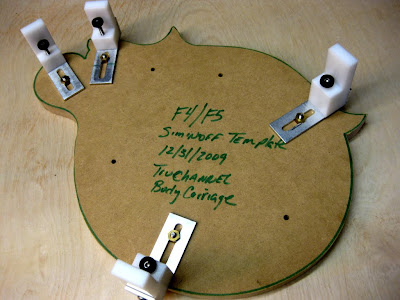I have to say ... when I decided to build an F4 vs an F5 at the Siminoff camp, ONE of the things that drew me to that decision was what I considered the simple beauty of the oval soundhole on the F4 mandolin vs the "f holes" on the F5 style ... I have 3 mandolins with "F holes" as it is and wanted to change things up a bit .. and I had read that the F4's have a more mellow less "cut through" sound than the F5 ... of course that is what the F5 is designed to do! Regardless once Roger said it was OK for me to do an F4 at camp that beautiful oval soundhole surrounded by that elegant multi-layer rosette was often on my mind as the camp approached.
Now I was fully aware that I couldn't use the same techniques to cut the channel for an oval hole that I had employed on several steel string acoustic guitars I had built in the past ... heck those were easy ... slap a cutter in a jig on a drill and in a couple of minutes ... viola!! a perfect round channel for the inlay! I hadn't REALLY thought this whole "oval thing" through though ... basically ... "there ain't no jig!" ... you may dance a jig while you cuss the effort ... you may play a jig while contemplating how you are going to recover from your most recent disastrous effort of cutting the oval channel but ... I could find no good "jig" to ease the task.
The following couple of pictures were taken while still at camp as I discussed the upcoming ordeal with Roger ...
| From Lutherie |
| From Lutherie |
... now the instructions that come with the rosette (purchased from Roger) are pretty clear and simple ... basically 'trace the outline of the rosette on the soundboard and cut to fit ...' ... uh-huh --- I built a banjo once from a kit and the instructions for that were pretty simple too --- "Open Box, remove contents, assemble banjo..." ... pretty much the same thing here ... no real mention of "the best way to carve out the channel..." or ... "watch out when you do this ... because ... you aren't gluing into a dark wood like ebony where you can hide poor craftsmanship with colored glue .... " ... oh no ... here you are cutting a channel for a fixed size piece of inlay that will be laid in a basically "white" spruce soundboard ... so ... have a nice time buddy cause you only get one shot ...
I'm not the most skilled "carver" on the planet ... and the intimidation of knowing I wanted to keep the soundboard basically light toned in color (perhaps a sunburst haven't decided yet) coupled with the "arch" of the soundboard and lack of any helpful jigs has made my workbench life fairly miserable for the last couple of weeks as I tried one thing and then another ... some I'm not willing to reveal due to their complete failure and obvious poor choice ... but after all is said and done if you don't look too close!! the result is "acceptable" but by no means as good as I had in my early visions of F4 bliss ... so ...
Here we have the effort early in the game and one of the tools I used to do much of the work ...
 |
| From Lutherie |
... there's already storm clouds brewing at this point ...
 |
| From Lutherie |
I was feeling KINDA OK at this point but the fit is already not "perfect" ...
 |
| From Lutherie |
Ahhh yes ... the whole "how do I glue this thing ??? " question ... this was one of several dry fit glue configurations I tried ...
 |
| From Lutherie |
... and even after I had settled on one clamp scheme that SEEMED to be reliable ... when I put the wax paper under the cauls ... all "heck" broke loose and clamps, and cauls were sliding all over the place ... and NOT holding a darn thing ... and of course by that time I was gluing for real ... regardless I "... danced a jig while cussing the whole situation ..." (at least I suspect it LOOKED like I was dancing as I was racing around the workbench trying to figure out how in blazes I was going to get the clamps to hold!!) ...
I did FINALLY get it clamped as best I could but there was some significant "less than perfectness" to deal with afterward ...
 |
| From Lutherie |
So ... after "playing a jig" or 10 ... and sanding ... and trimming ... and a bit of witchcraft and magic ... I ended up with ...
 |
| From Lutherie |
It doesn't bear real close examination and I'm hoping to hide a few flaws with creative finishing ... but ... it is what it is ...
Now on to laying in the headstock decoration ...















